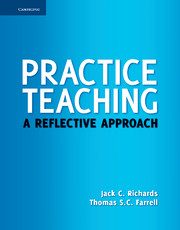Book contents
- Frontmatter
- Contents
- Introduction
- Chapter 1 Learning to Teach Through Practice Teaching
- Chapter 2 The Nature of Teacher Learning
- Chapter 3 Understanding the Teaching Context
- Chapter 4 Working With Your Cooperating Teacher
- Chapter 5 Planning Your Teaching
- Chapter 6 Teaching an Effective Language Lesson
- Chapter 7 Classroom Observation in Teaching Practice
- Chapter 8 Creating an Effective Classroom Learning Environment
- Chapter 9 Developing Learner-Centered Teaching
- Chapter 10 Classroom Discourse and Communication
- Chapter 11 Exploring Your Own Teaching
- Chapter 12 After Teaching Practice
- References
- Author Index
- Subject Index
Chapter 9 - Developing Learner-Centered Teaching
Published online by Cambridge University Press: 05 October 2012
- Frontmatter
- Contents
- Introduction
- Chapter 1 Learning to Teach Through Practice Teaching
- Chapter 2 The Nature of Teacher Learning
- Chapter 3 Understanding the Teaching Context
- Chapter 4 Working With Your Cooperating Teacher
- Chapter 5 Planning Your Teaching
- Chapter 6 Teaching an Effective Language Lesson
- Chapter 7 Classroom Observation in Teaching Practice
- Chapter 8 Creating an Effective Classroom Learning Environment
- Chapter 9 Developing Learner-Centered Teaching
- Chapter 10 Classroom Discourse and Communication
- Chapter 11 Exploring Your Own Teaching
- Chapter 12 After Teaching Practice
- References
- Author Index
- Subject Index
Summary
INTRODUCTION
When you begin your practice-teaching experience you will naturally be concerned with how well your students respond to you as a teacher and to your lessons. You will want to make a good impression on your students and to communicate the sense that you know what you are doing and that your lessons have been carefully planned. You will doubtless be somewhat critical of your own performance, evaluating your lessons on the basis of how successful they were in realizing your goals as well as how well they reflected the principles you have studied in your teacher education course.
But teaching is much more than a performance by the teacher. Above all, a successful lesson makes the learners – rather than the teacher – the focus of the lesson. Was the lesson content something students could relate to and that was relevant to their needs? Were the activities students took part in during the lesson sufficiently challenging to engage them but not so challenging that they became frustrated and lost interest? Were the students motivated during the lesson? Did the lesson provide opportunities for active participation by all the students in the class or was it dominated by one or two students who monopolized questions and discussion? In this chapter we will explore how you can move from a teacher-centered approach to teaching to a learner-centered one, that is, one in which students' needs, interests, and preferences take priority in teaching.
- Type
- Chapter
- Information
- Practice TeachingA Reflective Approach, pp. 120 - 133Publisher: Cambridge University PressPrint publication year: 2011



